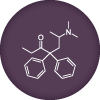Learning Objectives
By the end of this topic, the student should be able to:
- Explain the mechanism of action of opioids.
- Describe the medical indications for the short-term use of opioids.
- Describe the medical indications for opioid use over longer periods of time.
- Identify the types of drug interactions involving opioids and their consequences.
- Discuss how opioid use can result in tolerance, dependence, and withdrawal.
Key Concepts
- The brain produces several opioid peptides that activate three receptors: μ (mu), δ (delta), and κ (kappa), collectively called the opioid system.
- The opioid system exerts its activity across multiple physiological systems, including the regulation of pain.
- Opioids have morphine-like effects in the body and activate opioid receptors.
- Opioids are used to treat acute pain, chronic cancer pain, and sometimes other types of chronic pain.
- Opioids are also used for recreational purposes, for self-medication, and to treat symptoms of opioid withdrawal.
- Adverse effects of opioids include sedation, nausea, constipation, and itchy skin. Respiratory depression is the most serious and potentially fatal adverse effect (respiratory depression and its reversal by naloxone are addressed in Module 8, Topic E
- Opioids used over long periods of time may cause adverse effects, including sleep disturbances and hormonal changes.
- Opioids can interact with other medications, such as central nervous system depressants, that increase the risk for adverse consequences, including respiratory depression/overdose.
- Continued use of opioids can result in tolerance. Tolerance occurs when a person needs to use an increasing amount of an opioid to obtain the same effect.
- Continued use of opioids can result in dependence. An opioid-dependent person will experience symptoms of withdrawal if opioids are stopped abruptly.
Opioids – The Basics
When most people think of opioids, they usually think of medicines or unregulated drugs. In fact, the human body produces more than 20 opioids as part of its natural neuroregulation processes. Opioids produced in the body are considered endogenous opioids. This is in contrast to exogenous opioids, which are opioids one might use for medicinal or other purposes. Exogenous opioids are either plant-derived or synthetic.
Types of Endogenous Opioids
Plant-derived or synthetic opioids are all large organic molecules; however, endogenous opioids are small peptides (i.e., made up of amino acids). These opioid peptides are derived from larger proteins (preproopiomelanocortin, preproenkephalin, and preprodynorphin).
There are three main types of endogenous opioid peptides:
- endorphins
- enkephalins
- dynorphins
Opioid Receptors in The Body
Both endogenous opioid peptides and exogenous opioids (medicines, drugs) act primarily via three opioid receptors:
- µ (mu),
- δ (delta), and
- κ (kappa).
Although all three opioid receptors are expressed throughout the body and across many systems, mu opioid receptors are sometimes referred to as supra-spinal because they mediate many of the effects in the brain, including acting in the reward system (i.e., limbic system).
Most opioids are considered full agonists, which means they can maximally activate opioid receptors. Some are partial agonists that only partially activate receptors.
Full agonists examples:
- morphine,
- oxycodone,
- fentanyl, and many others.
Partial agonist example:
- buprenorphine
How Do Opioids Treat Pain?
Opioids are used primarily for their pain-relieving (analgesic) effects for moderate to severe acute pain due to a variety of causes.
Pain is signaled to the brain via activation of the ascending pain pathway.
- The ascending pain pathway delivers the pain signal from the source of the pain to the brain.
- Activation of opioid receptors inhibits this pathway.
The body (including the opioid system) is able to dampen pain by activating the descending inhibitory pathway. This pathway works from the brain down to the spinal cord, so works in the opposite direction of the ascending pain pathway. The pathway inhibits the ascending pain signal.
Short-Term Opioid Use

Opioids are used primarily for their analgesic pain-relieving (analgesic) effects for moderate to severe acute pain from a variety of causes.
Opioids relieve pain by:
- blocking pain transmission from the source of the pain to the brain, via the spinal cord
- increasing the activity of the descending inhibitory pathway, also in the spinal cord, that further reduces pain
- decreasing the subjective perception of pain (i.e., increased pain tolerance)
Less commonly, opioids are used to suppress severe cough and to treat diarrhea, and they are used in palliative care for dyspnea (difficult or laboured breathing).
Opioids are also used in combination with other drugs in anesthesia for surgeries and medical procedures.
Adverse effects of short-term opioid use may include sedation, sleepiness, nausea and vomiting, constipation, itchiness, and others. See Module 8, Topic B for more information.
The most serious adverse effect, respiratory depression, and its reversal by naloxone are discussed in Module 8, Topic E.
Long-Term Opioid Use

Although opioids are used for a wide variety of acute pain, their use and effectiveness for most types of chronic pain are controversial.
- Opioids are frequently used for chronic cancer pain.
- Opioids are sometimes prescribed for chronic non-cancer pain but are often considered less effective over time.
- Alternatives to opioids, such as non-opioid analgesics including acetaminophen and nonsteroidal anti-inflammatory drugs (NSAIDs) should be tried first, and antidepressants and anticonvulsants, are preferred for chronic nerve pain.
- When opioids are used for chronic pain, best practices suggest keeping the daily doses below 90 MME (morphine equivalents), if possible, to frequently assess and reassess for effectiveness and adverse effects, and to avoid using other central nervous system (CNS) depressants, particularly benzodiazepines such as diazepam (Valium).
In addition to the adverse effects of opioids associated with short-term use, long-term use of opioids can cause:
- hyperalgesia (when opioids worsen pain instead of improving it),
- tolerance,
- dependence and withdrawal, and
- opioid use disorder.
Long-term opioid use is also linked to
- hormonal changes that can affect mood and cause sexual dysfunction,
- amenorrhea (the absence of menstruation), and
- gynecomastia (breast enlargement).
Opioids and Drug Interactions
Drug interactions can be classified into types: pharmacokinetic, pharmacologic/pharmacodynamic, and physiological.
Pharmacokinetic Drug Interactions
Definition
- Pharmacokinetic Drug Interactions
- Pharmacokinetic drug interactions occur when one drug alters the absorption, distribution in the body, metabolism, or excretion of another drug, all of which have the potential to impact the drug’s effect in the body.
If a pharmacokinetic drug interaction increases the level of opioids, a person may experience increased or more intense adverse effects, including the possibility of respiratory depression.
If a pharmacokinetic drug interaction decreases the level of opioids, a person may experience reduced pain control or withdrawal symptoms.

Methadone is metabolized by an enzyme in the liver called CYP3A4.
- The antidepressant fluvoxamine inhibits CYP3A4 activity, resulting in increased methadone levels.
- Some anti-seizure medications can induce CYP3A4 (increase the number of enzymes), and methadone levels will fall.
Pharmacologic/Pharmacodynamic Drug Interactions
A pharmacologic/pharmacodynamic drug interaction occurs when two drugs act on the same receptor.

Morphine activates opioid receptors and naloxone blocks opioid receptors.
Physiological Drug Interactions
Physiological drug interactions occur when two drugs have similar or opposing effects on the body. For example, one drug increases blood pressure, and a second drug decreases blood pressure—these two drugs have an opposing physiological effect.

For opioids, the sedative/CNS depressant properties can combine with those effects caused by other CNS depressants, including alcohol, benzodiazepines, and barbiturates, that also depress respiration.
Often, CNS depressants work together synergistically to cause sedation or respiratory depression.
Tolerance
Like all systems in the body, the opioid system is constantly fine-tuned. If the system becomes over-activated, the body takes steps to reduce this activity, and if the system is downregulated, the body takes steps to increase activity.
Definition
- Exogenous Opioids
- Opioids from an external source rather than those the body produces itself.
When exogenous opioids are taken, the endogenous opioid system detects the over-activity they cause, and reacts by reducing activity. It does this by reducing production of endogenous opioid peptides and reducing the number of opioid receptors, among other things.
- At this stage, the body has begun to adapt to the presence of the exogenous opioid.
- As the body adapts, tolerance can occur: the person needs more and more of the drug to produce the same effect.
If opioid use is stopped, the opioid system returns back to its original state over time.
Dependence and Withdrawal
With continued use, the body’s opioid system activity may be further and further impaired. Eventually, endogenous opioid system activity is reduced to the point that the body becomes reliant on continued exogenous opioids—termed opioid dependence.
Once a person is dependent on opioids, they will experience symptoms of opioid withdrawal if they stop taking opioids. How fast these withdrawal symptoms start depends on the half-life of the opioid used:

Tzido/iStock
- muscle aches and weakness
- diarrhea and stomach cramps
- nausea and vomiting
- shivering/goose bumps
- yawning
- sweating, changes in body temperature
- anxiety
- restlessness
- sneezing and runny nose
- fast heart rate
- sleep disturbances
When these symptoms occur, they are readily reversed by additional doses of an opioid. Withdrawal symptoms can be minimized by tapering the dose of the opioid.
Withdrawal severity is assessed clinically using the Clinical Opiate Withdrawal Scale (COWS) (Wesson & Ling, 2003).
Questions
Why might switching from methadone to buprenorphine cause withdrawal symptoms?
Feedback
Methadone is a full (100 percent) opioid receptor agonist. Buprenorphine is a partial agonist. Buprenorphine activates opioid receptors but only partially (let’s assume 50 percent). So, if someone were to take buprenorphine alone, their opioid receptor activation would increase from baseline (0) to 50 percent. However, if a full agonist is present, buprenorphine reduces opioid receptor activation (let’s assume from 100 percent towards 50 percent) and can precipitate withdrawal symptoms. Thus, careful dosing, timing, and consideration are required when switching from methadone to buprenorphine.
References
Brunton, L. L., Hilal-Dandan, R., & Knollmann, B. C. (2018). Goodman and Gilman’s the pharmacological basis of therapeutics (13th ed.). McGraw-Hill Education.
DiPiro, J. T., Yee, G. C. L., Posey, M., Haines, S. T., Nolin, T. D., & Ellingrod, V. (2019). Pharmacotherapy: A pathophysiologic approach (11th ed.). McGraw-Hill Education.
Katzung, B. G. (2018). Basic and clinical pharmacology (14th ed.). McGraw-Hill Education.
McCance-Katz, E. F., Sullivan, L., & Nallani, S. (2010). Drug interactions of clinical importance among the opioids, methadone and buprenorphine, and other frequently prescribed medications: A review. American Journal on Addictions, 19, 4–16.
Wesson, D. R., & Ling, W. (2003). The Clinical Opiate Withdrawal Scale (COWS). Journal of Psychoactive Drugs, 35, 253–259.